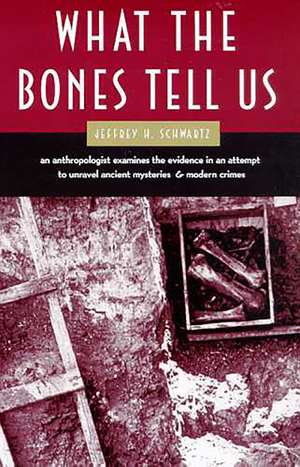What the Bones Tell Us
Autor Jeffrey H. Schwartzen Limba Engleză Paperback – dec 1997
A physical anthropologist exposes the inner workings of archaeology and anthropology, illustrating what can be learned from fossils and fragments of ancient cultures and civilizations. Schwartz ranges from digs in the Negev Desert through Africa and Europe to the local coroner's office to explain how interpretations of the past are made.
Preț: 186.68 lei
Preț vechi: 233.01 lei
-20% Nou
Puncte Express: 280
Preț estimativ în valută:
35.73€ • 38.79$ • 30.01£
35.73€ • 38.79$ • 30.01£
Carte indisponibilă temporar
Doresc să fiu notificat când acest titlu va fi disponibil:
Se trimite...
Preluare comenzi: 021 569.72.76
Specificații
ISBN-13: 9780816518555
ISBN-10: 0816518556
Pagini: 292
Dimensiuni: 152 x 229 x 18 mm
Greutate: 0.43 kg
Editura: University of Arizona Press
Colecția University of Arizona Press
ISBN-10: 0816518556
Pagini: 292
Dimensiuni: 152 x 229 x 18 mm
Greutate: 0.43 kg
Editura: University of Arizona Press
Colecția University of Arizona Press
Notă biografică
Jeffrey H. Schwartz is a professor of physical anthropology at the University of Pittsburgh and a research associate at the American Museum of Natural History.
Recenzii
“Scholarly sleuth Schwartz actually helps solve murders while exploring human evolution.”—Columbia Magazine
“It demonstrates how the skills of the forensic anthropologist carry over to the study of ancient populations when these are represented by a preserved skeletal series in a mortuary deposit. . . . Schwartz ably demonstrates how through such investigations new data can become available on matters about which historical records and other archaeological materials are silent.”—Science
“In a field often ruled by cockiness, Schwartz’s reticence to make judgments is refreshing. Related to this, and even more welcome, is his rejection of scientific dogma. . . . Schwartz gives us the bare bones and more about the science of osteological analysis.”—Kirkus Reviews
“Students of osteology and anatomy will learn much from Mr. Schwartz’s book, which is actually several books in one.”—Malcolm W. Browne, New York Times Book Review
“An easily readable, informative, enjoyable, thought-provoking commentary, interspersed with warm, refreshing tales. . . . It should interest both general and medical readers, dealing as it does with a subject that is near and dear to our hearts: our bones.”—Journal of the American Medical Association
“It demonstrates how the skills of the forensic anthropologist carry over to the study of ancient populations when these are represented by a preserved skeletal series in a mortuary deposit. . . . Schwartz ably demonstrates how through such investigations new data can become available on matters about which historical records and other archaeological materials are silent.”—Science
“In a field often ruled by cockiness, Schwartz’s reticence to make judgments is refreshing. Related to this, and even more welcome, is his rejection of scientific dogma. . . . Schwartz gives us the bare bones and more about the science of osteological analysis.”—Kirkus Reviews
“Students of osteology and anatomy will learn much from Mr. Schwartz’s book, which is actually several books in one.”—Malcolm W. Browne, New York Times Book Review
“An easily readable, informative, enjoyable, thought-provoking commentary, interspersed with warm, refreshing tales. . . . It should interest both general and medical readers, dealing as it does with a subject that is near and dear to our hearts: our bones.”—Journal of the American Medical Association
